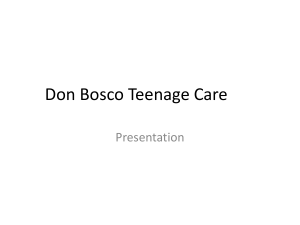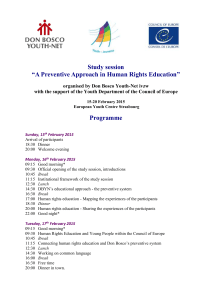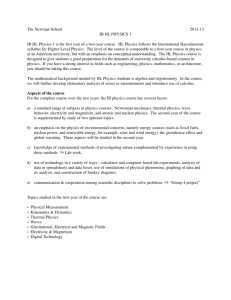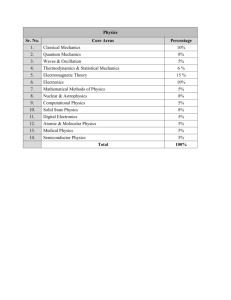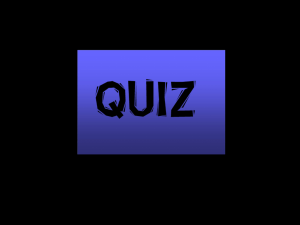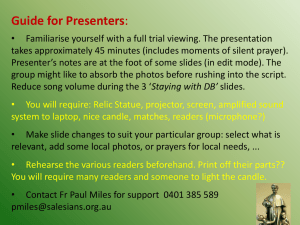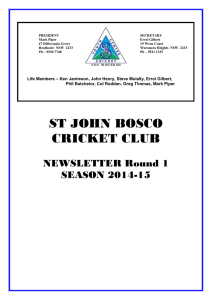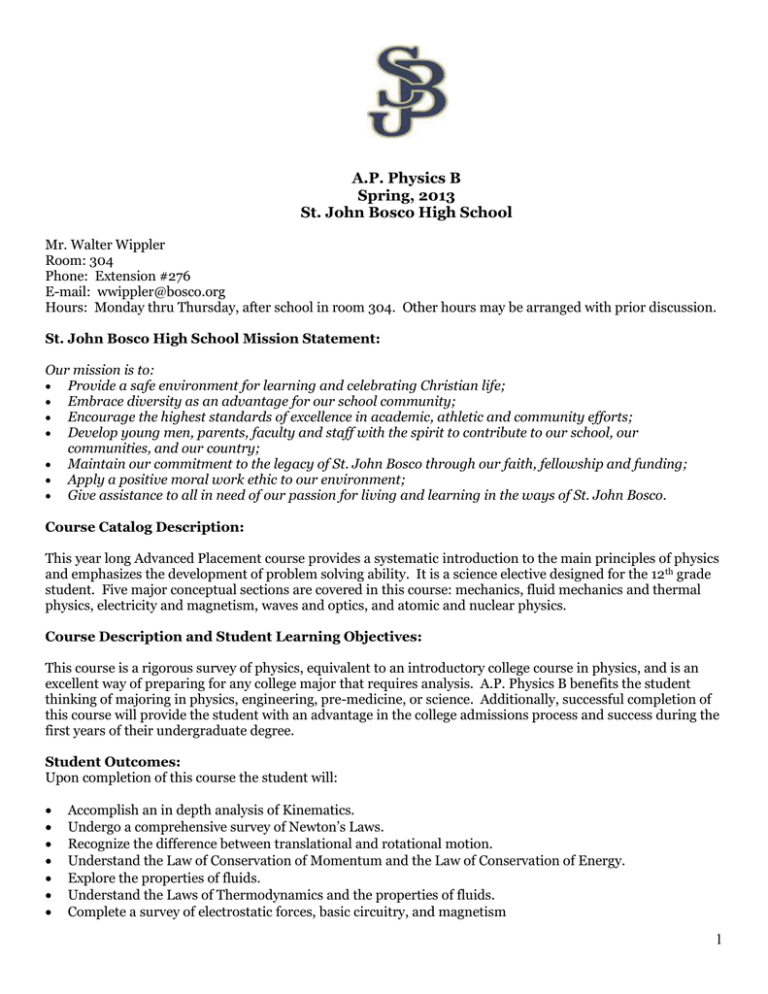
A.P. Physics B
Spring, 2013
St. John Bosco High School
Mr. Walter Wippler
Room: 304
Phone: Extension #276
E-mail: wwippler@bosco.org
Hours: Monday thru Thursday, after school in room 304. Other hours may be arranged with prior discussion.
St. John Bosco High School Mission Statement:
Our mission is to:
Provide a safe environment for learning and celebrating Christian life;
Embrace diversity as an advantage for our school community;
Encourage the highest standards of excellence in academic, athletic and community efforts;
Develop young men, parents, faculty and staff with the spirit to contribute to our school, our
communities, and our country;
Maintain our commitment to the legacy of St. John Bosco through our faith, fellowship and funding;
Apply a positive moral work ethic to our environment;
Give assistance to all in need of our passion for living and learning in the ways of St. John Bosco.
Course Catalog Description:
This year long Advanced Placement course provides a systematic introduction to the main principles of physics
and emphasizes the development of problem solving ability. It is a science elective designed for the 12 th grade
student. Five major conceptual sections are covered in this course: mechanics, fluid mechanics and thermal
physics, electricity and magnetism, waves and optics, and atomic and nuclear physics.
Course Description and Student Learning Objectives:
This course is a rigorous survey of physics, equivalent to an introductory college course in physics, and is an
excellent way of preparing for any college major that requires analysis. A.P. Physics B benefits the student
thinking of majoring in physics, engineering, pre-medicine, or science. Additionally, successful completion of
this course will provide the student with an advantage in the college admissions process and success during the
first years of their undergraduate degree.
Student Outcomes:
Upon completion of this course the student will:
Accomplish an in depth analysis of Kinematics.
Undergo a comprehensive survey of Newton’s Laws.
Recognize the difference between translational and rotational motion.
Understand the Law of Conservation of Momentum and the Law of Conservation of Energy.
Explore the properties of fluids.
Understand the Laws of Thermodynamics and the properties of fluids.
Complete a survey of electrostatic forces, basic circuitry, and magnetism
1
Accomplish an analysis of the Electromagnetic Spectrum
Gain an understanding of Einstein’s Special Theory of Relativity, the evolution of Quantum Mechanics and
Nuclear Physics.
Read and comprehend technical and scientific writing.
Continue the development of critical thinking skills.
Make experimental observations, make conclusions and report the conclusions in writing.
Demonstrate the ability to manipulate algebraic equations and solve for any variable.
Course Objectives:
Students will:
Mechanics
Use kinematics in order to determine the position or displacement, speed or velocity, relative velocity and
acceleration of an object at any point in time.
Understand the difference between a static system and a dynamic system.
Use Newton’s Law’s to explain how a force changes the momentum of an object and how force produces
acceleration.
Apply the Law of Conservation of Momentum, to closed systems.
Know the difference between weight and mass.
Identify and understand the relationship between different kinds of forces.
Understand that force is the agent of change in translational motion while torque is the agent of change in
rotational motion.
Use Newton’s Law of Universal Gravitation and Kepler’s Three Laws of Planetary Motion to describe the
motion of the planets around the Sun, or any object moving around a central mass.
Use kinetic energy and potential energy to show that energy is conserved.
Fluid Mechanics and Thermal Physics
Use the idea of buoyant force, Pascal’s Principle and Bernoulli’s Equation to describe the behavior of fluids.
Use linear expansion to describe the thermal properties of solids, liquids and gases.
Use the Carnot Cycle to demonstrate the First and Second Law of Thermodynamics.
Electricity and Magnetism
Use Coulomb’s Law to determine the force between two charges.
Use Ohm’s Law to show the relationship between voltage, current, and resistance.
Be able to identify a series or a parallel circuit.
Understand the properties and effects of magnetic fields.
Understand and apply Faraday’s law and Lenz’s law
Waves and Optics
Able to identify the different regions of the electromagnetic spectrum.
Understand and identify the difference between a longitudinal wave and a transverse wave.
Apply the relationship between frequency, wavelength and speed to all electromagnetic waves.
Use the Doppler Effect to explain the change in frequency when the source and receiver are in motion
relative to each other.
Demonstrate how open ended and closed-ended pipes influence the frequency of sound.
Know the speed of sound and its dependence on temperature.
Use Planck’s constant to determine the energy of a photon.
Know the speed of light in a vacuum.
Use the Law of Reflection and the Law of Refraction (Snell’s Law) to explain the scattering of an
electromagnetic wave.
Use the Gaussian Lens Equation to demonstrate how a lens or mirror manipulates waves through
refraction or reflection.
2
Atomic, Nuclear, and Quantum Physics
Understand the constancy of the speed of light.
Understand the wave-particle duality of light
Use Einstein’s Principle of Relativity to determine time dilation and length contraction of an object moving
closely to the speed of light.
Use Einstein’s Special Theory to determine the rest energy of a mass.
Understand the use of the emission spectrum and absorption spectrum in identifying different elements.
Understand the photoelectric effect.
Understand the basic operation of a laser.
Understand the basic operation of nuclear fission and fusion.
Required Readings:
Giancoli, Douglas C. Physics: Principles with Applications, 6th ed. New Jersey: Pearson,
Prentice-Hall, 2005
Description of Assignments:
Learning Experiences: will be given at the end of every chapter or approximately every two weeks.
Partial credit will be given when relevant work is done. Make-up Learning Experiences will be given
ONLY on EXCUSED absences.
Reality Checks: will be given to check the students understanding of a particular subject that was
recently covered in class. A Reality Check will take no more than 10 to 15 minutes to complete. Partial
credit will be given when relevant work is done. Make-up Reality Checks will be given ONLY on
EXCUSED absences.
Lab reports. The student will perform labs in order to support topics discussed during lecture. Lab
reports are due on date specified by instructor. Partial credit will be given when relevant work is done.
Homework/Worksheets will be assigned in order to help the student understand the current topic
covered in class. Homework problems and worksheets are turned in for a grade. Late homework will
receive 1/2 credit.
Projects. During the year the student will apply the physics he has learned in a group project. Point
values and requirements for these projects will be given to the student at the appropriate times.
Grading/Assessment:
The grading scale for the class will follow the St. John Bosco “Approved Academic Grading Scale” found in the
Student-Parent Guide. Grades will be determined as followed:
Learning Experiences/Projects
40%
Reality Checks
20%
Lab Reports/Worksheets/Homework
25%
Final
15%
Any student who earns a grade of 60% or below on any assessment will be required to see Mr.
Wippler for tutoring.
Expectations:
1. Follow Directions! No exceptions!
2. Respect yourself and others. Mutual respect, trustworthiness, fairness, caring, responsibility
and citizenship are keys to a productive learning environment.
3. Be prepared for class every day.
4. No eating or drinking in class.
3
Rules and Procedures:
School rules as set forth by the Student/Parent Guide of Saint John Bosco High School will always
apply.
Beginning-of-Class:
1. Students are to enter the classroom through the front door only, take their seat and prepare for the
day’s class.
2. During attendance students are to complete the “Check-In” that will be projected on the white
board.
3. After completing the “Check-In”, students are to refer to the agenda for the day, prepare for prayer,
and have the necessary resources on their desk
Use of Materials and Equipment:
1. Students are not to use or handle and lab equipment or materials found in the lab area without
teacher permission.
2. Each student is to respect the property of his fellow student and his teacher. At no time is a student
allowed to take, borrow, or use supplies, materials, textbook, calculator, laptop, etc. from another
student or the teacher without obtaining permission first.
End-of-Class:
1. Just before the end of class, each student will again refer to the day’s agenda for directions,
assignments/homework, etc.
2. All desks will be placed back in order and any trash will be removed from the floor. The classroom
will be clean, orderly, and quiet when students leave the room.
3. Students will be dismissed by the teacher and not by the bell.
4. Students are to exit the classroom through the front door only. At no time us a student allowed to
enter or exit the classroom through the back lab door. This is for student safety.
Seatwork:
1. During seatwork each student should maintain silence. No talking among or helping fellow
students.
2. Students are allowed out of their seats only to use the pencil sharpener.
3. If a student requires help he should raise his hand.
Group Work/Lab:
1. No student should be in the lab area until given permission by the teacher. Once permission is
granted, student is to stay at his assigned lab station.
2. All group members are expected to actively collaborate
3. Only material and equipment relevant to the lab activity are to be used/handled by the student. At
no time does a student have permission to handle or use any other equipment in the lab area. This
is for student safety.
4. Report any broken equipment to the teacher.
Lecture:
1. Student is expected to actively take notes.
2. Student should refrain from conversing with other students during lecture.
3. Directions will be given once only.
Use of Technology:
1. Students will use computers/electronic devices along with Internet access for academic purposes
only.
2. Students must come to school with a fully charged battery. No charging is allowed in class!
3. Students will not be granted work extensions for a failed computer, lost or corrupted work,
malfunctioning printer, etc. It is strongly recommended that students back-up all work on a regular
basis.
4. The Technology Acceptable Use Policy found on the Bosco website along with school rules as set
forth by the Student/Parent Guide of Saint John Bosco High School will always apply.
Student Participation:
1. Student should raise his hand and wait to be called on when asking a question or when responding
to a teacher asked question.
Miscellaneous:
1. Bathroom use during class is not allowed except in dire circumstances.
4
2. Students are free to use the pencil sharpener at any time during class without getting permission
from the teacher. It is asked that the student make his way to the pencil sharpener quietly and
without disturbing other students.
Course of Study – 2nd Semester
January
7 – 11
Chapter 16 - Electric Charge & Electric Field
Electric Charge (Q)
Coulomb's Law
Electric Field (E)
Field Lines
Electric Fields and Conductors
14 – 18
Chapter 17 - Electric Potential
Electric Potential Energy
Electric Potential Difference
Electric Potential due to a Point Charge
21 – 25
Chapter 17 - Electric Potential
Capacitance (C)
21st – Martin Luther King Holiday
24th – Bridge Bust
28 – Feb 1
February
4–8
Chapter 18 - Electric Currents
Voltage (V)
Current (I)
Resistance (R)
Ohm's Law
Power
Alternating Current
Chapter 19 - DC Circuits
Electromotive Force (EMF)
Resistors in Series & Parallel
Capacitors in Series & Parallel
Kirchhoff's Laws
RC Circuits
11 – 15 Chapter 20 - Magnetism
Magnetic Fields (B)
Electric Currents & Magnetic Fields
18 – 22
Chapter 20 - Magnetism
In a Magnetic Field, Force on a:
o Electric Current
o Electric Charge
o Straight Wire
th
18 – President’s Day
5
March
25 – Mar 1
Chapter 10 – Fluids
Pressure
Pascal’s Principle
Archimeded Principle & Buoyancy
Fluid Dynamics
o Bernoulli’s Equation
4–8
Chapter 13 – Temperature and Kinetic Theory
Atomic Theory of Matter
Gas Laws
Chapter 14 – Heat
Chapter 15 – Thermodynamics
1st and 2nd Law of Thermodynamics
Heat Engines
Heat Pumps
11 – 15
Chapter 11 – Waves
Simple Harmonic Motion
o Pendulum
Transverse & Longitudinal Waves
Chapter 12 – Sound
Vibrating Strings & Air Columns
Interference
Doppler Effect
18 – 22
Chapter 23 – Light
Reflection & Refraction
Thin Lenses
Ray Diagrams
21st – Trading Places
22nd – Faculty Faith Formation
25 – 27
Chapter 24 – Nature of Light
Waves vs. Particles
Huygens’ Principle
Young’s Double Slit Experiment
28 Easter Vacation Begins
April
8 – 12
Chapter 26 – Special Theory of Relativity
Simultaneity
Time Dilation and Length Contraction
E = mc2
15 – 19
Chapter 27 – Quantum Theory
Planck’s Hypothesis
Photon Theory and the Photoelectric Effect
22 – 26
Chapter 30 – Nuclear Physics
Alpha Decay
Beta Decay
Gamma Decay
6
29 – May 3
A.P. Exam Prep
2nd – Marian Day
6 – 10
A.P. Exam Prep
13 – 17
13th – A.P. Physics B Exam
17th – Senior Exams
20 – 24
20th, 21st – Senior Exams
23rd – Senior Farewell
24th – Principal’s Day Off
27 – 30
27th – Memorial Day
Underclassmen Exams
Note: Topics are tentative and may be subject to change as the semester progresses.
7


